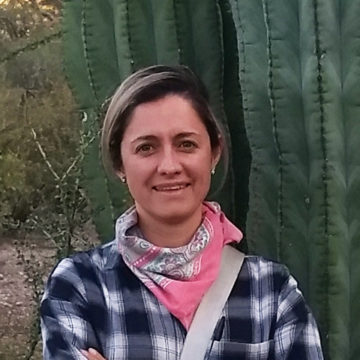Tania Hernandez
New World Succulents Cactus Scientist

Research Interests
- Origin, evolution and diversification of succulent lineages, with particular focus on Cactaceae and Agavoideae
- Origin and evolution of the succulent syndrome and the CAM strategy
- Evolutionary Genomics of succulent plants
- Plant evolution with a phylogenetic perspective
Personal Statement
The work in my lab is motivated by an interest to understand how and when the succulent syndrome appeared and how succulent lineages diversified. Besides being beautiful, succulent plants exhibit an interesting array of evolutionary modifications that occurred at all organismal levels (morphological, anatomical, physiological, genetic, etc.). We still do not fully understand the adaptive significance of those modifications in the context of the particular abiotic conditions under which different succulent lineages evolved around the globe.
Moreover, succulent lineages (for example those included in groups such as Cactaceae, Agave, Aizoaceae or Crassulaceae) show extraordinary diversity in terms of morphological variation and species numbers. Those lineages exhibit some of the highest speciation rates seen in the plant kingdom. However, the relationship amongst the succulent syndrome and the prolific radiation of these lineages in arid environments is not clear.
Finally, the advent of genomic data allows the study of the genetic bases of the evolution of succulent plants and the succulent syndrome in a comparative framework. Succulent plants show remarkable water use efficiency, and understanding their strategy at the genetic level might allow the generation of tools to face future scenarios of increased drought and heat predicted by all climate change scenarios.
Selected Publications
Hernández-Hernández, T., Martínez-Castilla, L.P. and E. Alvarez-Buylla. 2007. Functional diversification of B MADS-Box homeotic regulators of flower development: adaptive evolution in protein-protein interaction domains after major gene duplication events. Mol. Biol. Evol. 24(2):465-81
Hernández-Hernández, T., Hernández, H.M., Puente, R., Eguiarte, L.E. and S. Magallón. 2011. Phylogenetic relationships and evolution of growth form in Cactaceae (Caryophyllales, Eudicotyledoneae). Am. J. Bot. 98: 44-61
Hernández-Hernández, T., Colorado, W.B. and V. Sosa. 2013. Molecular evidence for the origin and evolutionary history of the rare American desert monotypic family Setchellanthaceae. Organisms Diversity & Evolution. 13:485–496.
Cornejo-Romero A., Medina-Sánchez J, Hernández-Hernández, T., Rendón-Aguilar, B., Valverde P.L., Zavala-Hurtado, A., Rivas-Arancibia S.P., Pérez-Hernández, M.A., López-Ortega, G., Jiménez-Sierra C., and C.F. Vargas-Mendoza. 2013. Quaternary origin and genetic divergence of the endemic cactus Mammillaria pectinifera in a changing landscape in the Tehuacán Valley, Mexico. Genetics and Molecular Research. 13(1):73-88
Anton, A.M., Hernández-Hernández T., De-Nova, J.A. and V. Sosa. 2013. Phylogenetic relationships of the monotypic family Halophytaceae based on molecular data. Botanical Sciences. 92: 351-361
Hernández-Hernández, T., Brown, J.W., Schlumberger, B.O., Eguiarte, L.E. and S. Magallón. 2013. Beyond aridification: multiple explanations for the elevated diversification of cacti in the New World Succulent Biome. New Phytologist. 202(4):1382-1397
Magallón, S., Gómez‐Acevedo, S., Sánchez‐Reyes, L. L., & Hernández‐Hernández, T. (2015). A metacalibrated time‐tree documents the early rise of flowering plant phylogenetic diversity. New Phytologist, 207(2), 437-453.
Vázquez-Lobo, A., Morales, G. A., Arias, S., Golubov, J., Hernández-Hernández, T., & Mandujano, M. C. (2016). Phylogeny and biogeographic history of Astrophytum (Cactaceae). Systematic Botany, 40(4), 1022-1030.
Sosa, V., Cameron, K. M., Angulo, D. F., & Hernández-Hernández, T. (2016). Life form evolution in epidendroid orchids: Ecological consequences of the shift from epiphytism to terrestrial habit in Hexalectris. Taxon, 65(2), 235-248.
Guerrero, PC, Majure, LC, Cornejo-Romero, A, Hernández-Hernández, T. (2019). Phylogenetic relationships and evolutionary trends in the Cactus family. Journal of Heredity 110 (1), 4-21
Hernández-Hernández, T. (2019). Evolutionary rates and adaptive radiations. Biology & Philosophy 34.4 (2019): 41
Shenton, M., Kobayashi, M., Terashima, S., Ohyanagi, H., Copetti, D., Hernández-Hernández, T., … & Ikawa, H. (2020). Evolution and Diversity of the Wild Rice Oryza officinalis Complex, across Continents, Genome Types, and Ploidy Levels. Genome Biology and Evolution, 12(4), 413-428.
Hernández-Hernández, T., & Wiens, J. J. (2020). Why Are There So Many Flowering Plants? A Multiscale Analysis of Plant Diversification. The American Naturalist, 195(6), 000-000.
